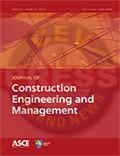The special collection of papers on Information Technology and the Built Environment is available in the ASCE Library (https://ascelibrary.org/jcemd4/it_and_built_environment).
In the recent decade, information technology (IT), including computing, communication, and sensing technology, has advanced extensively and radically transformed construction processes and built-environment management (Jang et al. 2021). Furthermore, the advances in artificial intelligence (AI) and big data analytics have enabled exploiting various types of data, making data-driven decisions, and improving the efficiency of operations. These enhanced data collection and analysis capabilities enabled by IT have made it possible to better manage construction operations and improve the built environment.
Smart building, one of the trendy topics in architecture, construction, and engineering (ACE), refers to building systems that serve as the infrastructure for providing essential data for the internet of things (IoT) and their communication in an integrated and intelligent way (Gao et al. 2021). With the networks of sensors, IoT devices, and developed software agents, smart building applications provide new functions to improve occupant health, comfort, and productivity, as well as building energy management through appropriate occupancy and system monitoring and planning (Chang et al. 2020; Mujan et al. 2019; Yu and Ergan 2021). Accordingly, it has been facilitated to acquire real-time data for the built environment, and researchers have focused on closing the gap between real situations and simulated predictions from the building models and interoperability among sophisticated networks of IoT devices and various software agents.
Productivity and safety concerns are always fundamental and important objectives in the construction industry (Hasanzadeh and de la Garza 2020), but the overall productivity of the construction industry is significantly lower compared to other key industrial sectors (Mckinsey Global Institute 2017). Information technology recently shows rapid development and proves to be mature enough to understand complicated and dynamic construction environments. Wearable sensors attached to construction laborers collect data related to the working environment, and the collected data is automatically exploited and analyzed through advanced algorithms such as artificial intelligence, thus resulting in better decision-making and efficient operation for enhancing productivity. For example, worker’s behavior and gestures induced from sensors like inertial measurement unit (IMU) and electromyography (EMG) can be analyzed to feasible features for better monitoring and managing workers’ performance and preventing their injuries (Kim and Cho 2021; Bangaru et al. 2020). To formulate real situations of complex problems, data-driven models based on AI with robustness in unstructured data are widely applied.
Other IT and the built environment approaches include studies exploiting the existing data or cloud sourcing to reduce the cost for the new data collection. The construction industry is a traditional area closely connected to public life, indicating the presence of tremendous amounts of data accumulated. These data can be a document like construction specifications, architectural drawings, as well as digitized ones like Unified Modeling Language for road utilities and infrastructure (Moon et al. 2021; Xu et al. 2020; Wu et al. 2021). Through advanced data analysis models such as AI-based natural language processing, useful information is extracted and transformed from existing data and utilized as characteristic information of the latest system (Kim and Ham 2021).
This special collection provides a comprehensive overview and discussion of recent technological and scientific advances and trends in the rapidly evolving information technology and its applications for the built environment.

